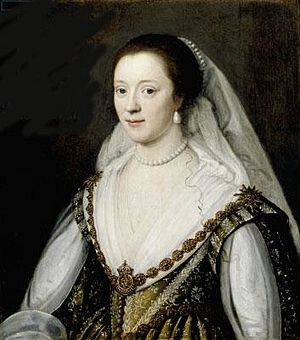Frances Coke, Viscountess Purbeck facts for kids
Quick facts for kids
Frances Coke, Viscountess Purbeck
|
|
|---|---|

Portrait of Frances Coke, Viscountess Purbeck, by Michiel Jansz. van Mierevelt (1623)
|
|
| Born | August 1602 |
| Died | 1645 Oxford |
| Spouse(s) | John Villiers, 1st Viscount Purbeck |
| Parent(s) | |
Frances Coke, Viscountess Purbeck (born August 1602 – died 4 June 1645), was a well-known figure in England during the early 1600s. She was the sister-in-law of George Villiers, 1st Duke of Buckingham, who was a close friend of King James VI and I. Frances became famous because of a big family drama known as "the Lady Purbeck’s business."
Contents
Early Life and Family
Frances was the younger daughter of Sir Edward Coke and his second wife, Lady Elizabeth Hatton. Her father was a very important judge and a member of the King's special council, called the Privy Council.
Frances was born in London at Hatton House. She was baptized on September 2, 1602, at St Andrew Holborn church.
A Forced Marriage
In 1617, when Frances was just fifteen years old, her father decided she should marry John Villiers, 1st Viscount Purbeck. John was the older brother of George Villiers, the Duke of Buckingham, who was very close to King James I. Sir Edward Coke hoped this marriage would help him get back into the King's good graces after he had lost his job as Lord Chief Justice.
Family Disagreement
Both Frances and her mother, Lady Hatton, did not want this marriage to happen. On July 10, Lady Hatton tried to hide Frances. She sent her daughter away from Hatton House without telling Sir Edward. Lady Hatton planned for Frances to stay with relatives and then perhaps marry someone else.
However, Sir Edward Coke found Frances at a house near Oatlands. He took her away and had her kept at the homes of important legal figures. It was rumored that Frances was treated very harshly to make her agree to the marriage.
The Wedding Day
In September 1617, Frances was married to Viscount Purbeck. The wedding took place at Hampton Court palace. The King and Prince Charles were both there. People at the wedding noticed that Frances was crying when she and John joined hands.
Life After Marriage
Frances's marriage was not a happy one. Viscount Purbeck was known to have serious mental health issues, which made his behavior unpredictable. In 1621, Frances and John decided to live separately.
A Son and Rumors
In October 1624, Frances gave birth to a son, who was named Robert Wright. Soon, rumors spread that the child's father was not Viscount Purbeck, but Sir Robert Howard. Sir Robert was a son of the Earl of Suffolk.
George Villiers, the Duke of Buckingham, seemed to be behind the efforts to investigate Frances. In February 1625, he asked the Lord Chief Justice to put both Frances and Sir Robert Howard in prison. Sir Robert was sent to Fleet Prison, and Frances was placed under house arrest in London.
Legal Troubles
In March 1625, Sir Robert Howard was publicly removed from the church (excommunicated) because he refused to answer the accusations against him. The legal process against Frances was paused for a short time.
Later, a group of twenty judges, including the famous poet John Donne, who was then the Dean of St Paul's Cathedral, heard Frances's case.
Later Life and Exile
Frances was ordered to perform a public act of penance, which meant standing barefoot in a white sheet in church. When she did not do this, she was again placed under house arrest.
Frances managed to escape by dressing up as a boy. She fled from London to France, where she lived in Paris for several years with her son. While in France, she became a Catholic. For a while, she stayed in a convent, but she did not become a nun.
In 1640, Frances asked the House of Lords to return the large sum of £10,000 that was part of her marriage payment. This money had been taken by the Villiers family. However, it seems she was not successful in getting it back.
Eventually, Frances returned to England during the time of the English Civil War. She became ill and died in May 1645, during the second siege of Oxford. She was about 42 years old. Frances was buried in the University Church of St Mary the Virgin in Oxford.
In Literature and Art
Frances Coke, Viscountess Purbeck, was a well-known person in her time. She was even mentioned in a play!
The dramatist Ben Jonson wrote a play called The Gypsies Metamorphosed in 1621. Frances was in the audience for the first performance. In the play, one of the characters speaks directly to her.
During her time living in Paris, Sir Kenelm Digby wrote about Frances. He said she showed great "prudence, sweetnesse, goodnesse, honor and bravery." He believed her difficult experiences had made her even stronger.
Arthur Wilson, an early historian, wrote in 1653 that Frances was a "Lady of transcending beauty."
Her Portrait
The only known painting of Lady Purbeck was created by the Dutch artist Michiel Jansz. van Mierevelt in 1623. This portrait can be seen by the public at Ashdown House, Oxfordshire, which is a National Trust property.

